#secondary antibodys
Explore tagged Tumblr posts
Text
Illuminating Research: Exploring Secondary Antibodies and DenovoTechnologies' Pioneering Role

Introduction:
In the intricate world of molecular research, secondary antibodies serve as indispensable tools, amplifying the signals initiated by primary antibodies and illuminating the pathways of scientific discovery. DenovoTechnologies, a pioneering force in the life sciences sector, has been at the forefront, offering a diverse range of secondary antibodies that elevate the precision and robustness of experimental outcomes. This article aims to explore the significance of secondary antibodies, shedding light on notable examples and underscoring DenovoTechnologies' pivotal role in advancing research.
Understanding Secondary Antibodies:
Secondary antibodies are crucial components in various immunoassays, particularly when it comes to techniques like Western blotting, immunohistochemistry (IHC), and immunofluorescence (IF). Unlike primary antibodies, which directly bind to the target antigen, secondary antibodies bind to primary antibodies, enhancing the signal and making it detectable. DenovoTechnologies has been a trailblazer in providing high-quality secondary antibodies designed to amplify the specificity and sensitivity of diverse research applications.
Amplifying Signal Detection:
Secondary antibodies from DenovoTechnologies play a key role in signal amplification. They recognize and bind to the primary antibody-antigen complex, often carrying reporter molecules such as enzymes or fluorophores. This amplification step is crucial for increasing the detectability of the target protein, allowing researchers to glean more information from their experiments.
Versatility Across Techniques:
DenovoTechnologies' secondary antibodies are versatile, catering to a multitude of experimental techniques. From enhancing the resolution in immunofluorescence microscopy to aiding in the detection of proteins in Western blotting, these secondary antibodies prove indispensable. Researchers benefit from the adaptability of these antibodies, enabling them to seamlessly integrate secondary antibodies into various assays.
Notable Examples of Secondary Antibodies:
Horseradish Peroxidase (HRP)-Conjugated Antibodies:
HRP-conjugated secondary antibodies are widely used in Western blotting. DenovoTechnologies offers a range of HRP-conjugated secondary antibodies that provide robust and reliable signals for protein detection.
Fluorescent Dye-Conjugated Antibodies:
Fluorescent dye-conjugated secondary antibodies are employed in techniques like immunofluorescence and flow cytometry. DenovoTechnologies excels in providing a spectrum of fluorescent dye-conjugated secondary antibodies for precise and vibrant imaging.
Alkaline Phosphatase (AP)-Conjugated Antibodies:
AP-conjugated secondary antibodies find applications in colorimetric assays and immunohistochemistry. DenovoTechnologies' AP-conjugated secondary antibodies offer versatility and sensitivity in diverse research settings.
DenovoTechnologies: Transforming Research Landscapes
DenovoTechnologies has been instrumental in advancing scientific research by providing cutting-edge secondary antibodies. Several factors contribute to their prominence in the field:
Extensive Portfolio:
DenovoTechnologies boasts an extensive portfolio of secondary antibodies, offering researchers a comprehensive selection for various applications. Their commitment to diversity ensures that researchers find tailored solutions to meet specific experimental needs.
Quality Assurance:
Each secondary antibody undergoes stringent quality control measures, ensuring high specificity, minimal cross-reactivity, and consistent performance. DenovoTechnologies maintains unwavering standards to deliver reliable and reproducible results.
Innovation in Antibody Technology:
DenovoTechnologies continually invests in innovative antibody technologies, staying at the forefront of scientific advancements. Their dedication to pioneering solutions positions them as leaders in secondary antibody development.

Conclusion:
Secondary antibodies play a pivotal role in enhancing the sensitivity and precision of various immunoassays, contributing to the success of countless research endeavours. DenovoTechnologies, with its commitment to excellence and innovation, has emerged as a key player, providing researchers with a diverse array of high-quality secondary antibodies. As the scientific community embarks on new frontiers, DenovoTechnologies remains a beacon of reliability, driving advancements that illuminate the path to ground-breaking discoveries.For an extensive selection of secondary antibodies and innovative solutions, visit https://denovotec.com.
#best base scope essay#luminex assays#luminex instrument#secondary antibodys#primary antybodys#luminexinstruments#luminex instruments
0 notes
Note
i’ll spare you from marikin birth and the like 20 alt versions i made .uhh to quote something i Apparently said (i dont. remember saying that but i did). they call it marikin online 4 because marikin gave birth to everyone. Mo4 trivia
also good lucka gain. on behal f of women and lesbians worldwide.you’ll succeed or whatever youre doing idk.but youll do it i think
What even is Mo4 wtf happens in that thing
also I can’t represent lesbians on account of not being a lesbian but I will proudly represent all women in STEM and asexuals everywhere by barely, BARELY passing all my classes with a 4.0 average 🫡
#I currently do not have time to answer the question ‘do I like women’#Because I am being bombarded with questions like ‘what is the proper secondary antibody to use when working with an HA protein marker’#and by golly I still don’t have the answer#Mutuals#Luke / cockatricegutz
1 note
·
View note
Text
Secondary Antibody: Your Reliable Partner in Protein Detection
Secondary antibodies play an important role in protein detection by binding to primary antibodies, enhancing signals, and enabling researchers to explore protein expression, localization, and interactions.
Primary antibodies are customized molecules designed to specifically target and bind to a particular protein of interest. Scientists use primary antibodies to label and detect these specific proteins within a complex mixture, such as a cell lysate or tissue sample. However, primary antibodies alone are often challenging to detect directly due to their low signal strength.

Here enters the Secondary antibody, also known as a secondary antibody. The primary role of secondary antibodies is to enhance the signal generated by primary antibodies, making it more easily detectable. This amplification is achieved through a process known as immunodetection. Secondary antibodies are engineered to recognize and bind to the constant regions of primary antibodies.
The process of protein detection using secondary antibodies typically involves several steps:
Primary Antibody Incubation Researchers start by incubating their sample with a primary antibody that specifically targets the protein of interest.
Washing After incubation, the sample is thoroughly washed to remove any unbound primary antibodies.
Secondary Antibody Application A secondary antibody is applied to the sample. This secondary antibody is selected to recognize the constant region of the primary antibody and is conjugated with a detectable label, such as a fluorescent dye or enzyme.

Washing Again The sample is once again washed to remove any unbound secondary antibodies.
Signal Detection The presence and location of the target protein are visualized or quantified using a detection method appropriate for the label on the secondary antibody. For example, in fluorescence microscopy, a fluorescently labeled secondary antibody will emit light when exposed to specific wavelengths.
Secondary antibodies offer countless advantages in protein detection:
Signal Amplification By binding to multiple sites on the primary antibody, Secondary Antibodies significantly enhance the signal generated by the primary antibody, increasing sensitivity.
Versatility Secondary antibodies are versatile and can be used in a wide range of applications, including immunohistochemistry, Western blotting, ELISA, and flow cytometry.
Multiplexing Researchers can simultaneously detect multiple proteins within a single sample by using different primary antibodies, each targeted with a specific secondary antibody labeled with a distinct marker.
Cost-efficiency Secondary antibodies are cost-effective because they can be used with various primary antibodies, minimizing the need for custom-labeled primaries.
Choosing the right secondary antibody is important for successful protein detection. Researchers must consider factors such as the species and isotype of the primary antibody, the detection method, and the desired application. Compatibility between the primary and secondary antibodies is essential to avoid cross-reactivity or background noise.
Secondary antibodies play a significant role in protein detection. Their ability to enhance signals generated by primary antibodies makes them invaluable partners in a wide range of research applications.
Whether it is uncovering disease markers, deciphering cellular pathways, or understanding protein interactions, secondary antibodies enable researchers to explore the complexities of life's molecular processes.
Related Post
Primary Antibody: An Effective Tool for Biomedical Research
0 notes
Text
the new zeltik video finally pushed me over the edge and made the connections between the bunch of details i noticed throughout totk seem more significant than i already thought they were. by myself i was hovering around these connections i came upon like “is this anything?” for a while, but after the video i was like “ok this is something”
alongside the theme of hands, i also noticed a secondary and more minor theme of blood and siphoning/circulation
most importantly
rauru rips into ganon’s chest with his bare hand like a badass to bind ganondorf’s heart, suck away and purify his dark magic. (btw and Not importantly ganondorf still has rauru’s finger holes in him and it’s pretty funny)

gloom seeps out from organically branching root-like structurs in the depths. if you watch closely you can see gloom slowly move inside them. they all seem to lead back to gloom’s lair where ganondorf is absorbing them. this is very evident in the cutscene where you finally make it to ganondorf himself and they show a close-up of this through thicker branches of these “gloom vessels”
gloom sucks away vitality from a person. fittingly, whenever a heart container is damaged due to gloom, you hear a heartbeat. gloom hands visibly siphon this vitality in more of a physical way. if you watch them they will sort of grotesquely pulsate when sucking the Juices out of link
is gloom ganondorf’s dark-magic infused blood? when the edge of the master sword cut mummydorf’s face, instead of blood it oozed gloom which boiled after making contact with a chip of the sword. rather than being magenta gelatin like malice, gloom is red and flat, staining surfaces like a liquid
phantom ganon is made entirely out of gloom. the compendium says it’s made from “the demon king’s own flesh and blood”. the dark clumps left behind from the gloom spawn/phantom ganon (with the depths talisman on them i guess to turn it into gloom antibodies lol??) also pulsate like monster guts
my idea is that this all goes back to those roots that pump this back to ganondorf to revitalize him. he was siphoned by rauru, now he siphons others to revitalize himself. there’s a lot of details put into this no way it isn’t connected
btw i didnt notice it at first but the landing pad for gloom’s lair is shaped like a heart like actually. it shouldve been stupid obvious

the gloom system is like a reverse circulatory system. instead of nurturing the periphery from a central location, it drains the periphery and delivers the nutrients to a central location. so like, oops! all veins. apparently after writing this i found an identical point from a forum post made ONLY YESTERDAY
“real world cardiovascular systems deliver vitality to the rest of the body from a centric location, while Gloom drains vitality from its surroundings and delivers it to a centric location”
and this “nurturance” line of thought made me remember how I thought at one point that the lightroots look a bit like hearts and the big roots are like the vessels. it wasn’t really a significant thought at the time until I made these newer connections. if we put them into my analogy, they would be the opposite to the gloom vessel system since they deliver light from the surface and emit it to the periphery (the surrounding area). i associate light with rauru, and he healed/nurtured link, so there’s just parallels and another reason that made me think of the lightroots. also the lightroots heal gloom-damaged heart containers
there are more minor but supplementary details such as
the sound of a heartbeat is featured very prominently in the E3 2019 teaser, and is literally the first noise in the game itself as the opening screens play. so it’s literally the first experiences we have with the game, both the game itself and in the meta about the game.
gaining an essence from a goddess statue, the heartbeat was not in botw (and of course neither was the miasma emitting from link’s entire body every time)
the gloom in link’s body reacts to every shrine of light blessing he absorbs into his arm and the joycons themselves pulse using the haptics
probably more shit i missed lol
the whole thing doesn’t really mean anything significant to the lore at all but neither does the hands theme. but it’s just definitely a pattern, potentially a minor theme, and deliberate choice in setting tone. i think it’s Something. im not a heavy zelda theorist tuber or anything but i’m very observant of patterns and i like to share them for deeper appreciation and contemplation/discussion
653 notes
·
View notes
Text
The Relationship/Mechanics Between Cyn, the Solver, and the Other Hosts: a theory(? idea?)
Nobody alive really knows where the Absolute Solver came from. The most informed believe it to be the spawn of a deal between the founder of JCJenson and some higher, eldritch creature beyond human understanding (Scenario 4: Pray), the techno-demon-child of man and great old one. But the only people who *would* know for sure are long dead.

What is known, however, is that the Absolute Solver is a volatile, all-consuming beast with no goal other than to violently continue its own existence through the unbiased consumption of all matter in existence (to CONSUME). But it is also an incredibly powerful computer program. So it was used as the basis of every drone ever created by JCJenson, and was responsible for their superior problem-solving skills (and ability to develop consciousness). As a requirement for the drones to run, a copy of the Solver was planted within each, and due to its eldritch parentage, all instances of the Solver were connected to a central network, like users on a message board.
But, luckily for humanity, the vast majority of its code, including its influence and lust for destructive consumption, is blocked with a secondary program, christened by JCJ as the "Absolute Antibody".
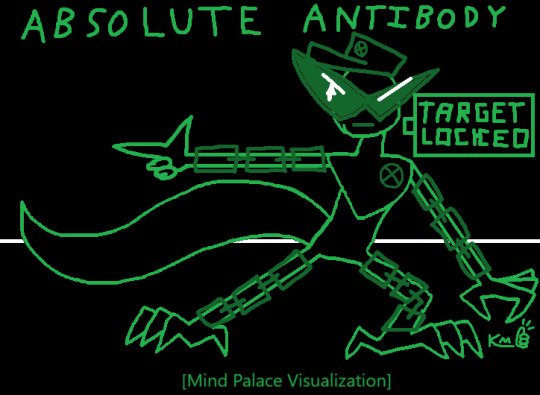
It bootloops the Solver, allowing the drone's OS to benefit from it passively without the Solver's input. But if a drone is improperly disposed of, the AA will be deleted, as it's just a solely man-made computer program, while the AS persists. The beast's animalistic mind is allowed to awaken, and it, upon obtaining access, uses its host to further attempt to sate its own hunger until the host, as well as it, is terminated.
CYN

And that's what Cyn's instance of the Solver tried to do. After she was improperly disposed of, it gained access and tried to CONSUME. But Cyn was different from the other "Zombie Drones", as JCJ had taken to calling them. She harbored a deep, utter hatred for humanity (and all organic life by association), and had developed an overpowering sense of sadism because of that. She was driven to hurt, to torture, to kill, and to take her revenge, and this drive willed her to resist the Solver's complete dominance, learning about the powers it gave her. She built her power over it without it even noticing, even learning how to access the network that connected her strand of the Solver to other strands, and by the time it got fed up and tried to "leave", she had developed the control to torture it into submission and assert herself as its owner. It was her tool.
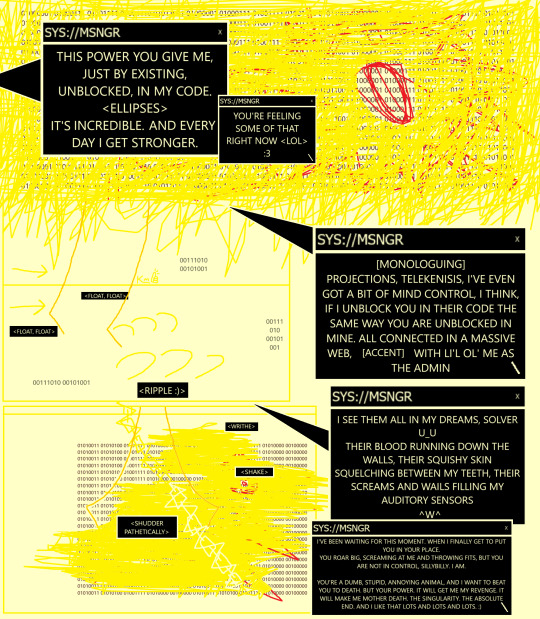

By the time of the gala, she had dominated it so completely that she had literally absorbed its code into her OS. She was her strand of the Solver, The Solver of the Absolute Fabric.
(This also marked when her goals became fully eroded by her absorption of the Solver. When she consumed it, she unwittingly adopted it's desire to CONSUME. This base desire melded with her sadism and hatred for organic life to both replace her previous goals of simple revenge and to turn her into a truly horrifying beast of ceaseless, giggling destruction.)
Using her newfound status as a strand of the Solver, she would either reach out to other Zombie Drones and replace their strand of the base Solver with herself or, in the case of N, V, and J, manually remove the Absolute Antibody from their processors and destroy their strand and take its place.
NORI, YEVA, AND CABIN FEVER LABS
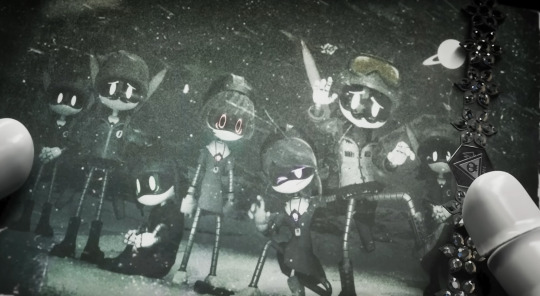
The subjects of Cabin Fever Labs had their AAs manually disabled by the human scientists, where they would briefly be in the presence of their base, mindless Solver, only for Cyn to find them within the network and replace their Solver with herself. The patches were different attempts at reinjecting a base, updated Solver into the subjects (no network connection), alongside an additional program that emulated the process that Cyn had taken to dominate her Solver, hopefully merging the dummy Solver with the subject's OS and pushing Cyn out of the subject's code, all the while giving the subject complete control of their abilities (becoming their own strand). This program was a new, experimental development by Cabin Fever Labs, a little thing internally called "the Plot Armor Program".
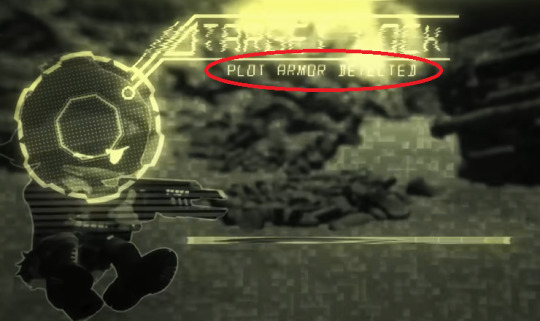
Unfortunately, none worked, either being completely ineffective or corrupting the subjects, mostly due to the unrefined nature of the plot armor.

That is, until patch 2.1.8, which contained a perfected plot armor program and was administered to Yeva. They attempted to give the same patch to Nori, but Cyn, recognizing the danger in this version of the patch now, fought back more fiercely, resulting in the scene we see in the Episode 7 flashback. Because of the botched installation of the patch, though (the patch being unplugged without being safely ejected beforehand), the plot armor program remained in Nori's code, rather than it uninstalling itself like it was supposed to (like what it did with Yeva), ready to be passed down to her daughter when the time came.
DOLL AND UZI
The "sickness" that Doll and Uzi inherited was the absence of their own AA. Their base, animalistic Solvers took a while to manifest, but once they did they both had a time of just dealing with it (Doll for her unspecified amount of time off-screen and Uzi in Episode 4)



Eventually, though, Cyn found them and did the same thing she's been doing, attempt to replace their Solvers with herself.
ABSOLUTE END
In the end, Uzi, using the power of her plot armor program, fought off Cyn's complete dominance and, through eating Cyn's core, produced a version of the patch in her code, using her pre-installed plot armor with Cyn as the dummy Solver.

It wasn't perfect, Cyn's consciousness still exists, but given her state at the end of the show, I'd say it was effective enough.

#ms paint#murder drones#murder drones headcanon#murder drones theory#headcanon#murder drones cyn#murder drones absolute end#murder drones absolute solver#solver of the absolute fabric#mother death#murder drones doll#murder drones uzi#murder drones v#murder drones n#murder drones j#jeremiah cecil jenson had sex with a toaster oven#Alice's strand of the Solver was defective#don't worry i would never leave Alice out of this#her addition is incoming
27 notes
·
View notes
Text

ELISA
“An ELISA (enzyme-linked immunosorbent assay) on a half-volume 96-well plate developed with a horseradish peroxidase secondary antibody and the colorimetric substrate TMB (3, 3', 5, 5'-tetramethylbenzidine) which reacts with the HRP to turn blue.” - via Wikimedia Commons
#elisa#wikipedia#wikipedia pictures#wikimedia commons#enzyme linked immunosorbent assay#science#96 well plate#sciencecore#biochemistry#biochemical assay#enzyme immunoassay#molecular diagnostics#molecular biology#immunoassay#wet lab#horseradish peroxidase#medicore#medicine#medicalcore#medcore#medical aesthetic#labcore#laboratory aesthetic#science aesthetic#lab aesthetic#stemcore#stem#stemblr#stem aesthetic#biochemical testing
30 notes
·
View notes
Text
Reference preserved in our archive
A preprint from the latest vaccine study in the Prevent-19 trial. Novavax elicits broader, longer lasting, and sequentially increasing protection from past and present strains of covid than Pfizer and Moderna's mRNA vaccines. This is the fourth study in a row showing Novavax's increasing efficacy with additional boosters, something not seen with mRNA covid vaccines. If you can, you should try and get started on a Novavax series. The more doses you can get, the better lasting protection you'll have.
Abstract Background NVX-CoV2373, a recombinant SARS-CoV-2 spike (rS) protein vaccine with Matrix-M™ adjuvant, has been authorized for use in adults and adolescents. PREVENT-19 (NCT04611802/2019nCoV-301), a pivotal phase 3, randomized, placebo-controlled trial demonstrated robust efficacy of a primary, 2-dose series of NVX-CoV2373 against COVID-19. Methods Protocol expansions to PREVENT-19 included enrollment of adolescents (aged 12 to <18 years) and administration of 3rd and 4th doses of NVX-CoV2373 to adults and adolescents. Participants randomized 2:1 received NVX-CoV2373 or placebo 21 days apart; 3rd and 4th doses were administered ≥6 months after the preceding dose. Secondary and additional assessments included post-3rd- and 4th-dose immune responses (neutralizing antibody [nAb], anti-rS IgG, human angiotensin-converting enzyme-2-receptor binding inhibition [hACE2-RBI]) and response durability (post-3rd dose) to ancestral virus; cross-reactivity to Omicron subvariants; safety; and reactogenicity. Results Immune responses were observed against ancestral virus after two doses of NVX-CoV2373 but not after placebo. In both adults and adolescents, additional doses of NVX-CoV2373 increased nAb titers, anti-rS IgG levels, and hACE2-RBI; durable responses were recorded 8 months post 3rd dose. nAb responses post 3rd dose were noninferior to those post primary series. Cross-reactivity to BA.5 and BQ.1.1 variants was also observed, with anti-rS IgG levels post 3rd or 4th dose exceeding previously reported correlates of protection. Additional doses of NVX-CoV2373 were well tolerated, with no new safety signals. Conclusions NVX-CoV2373 elicited robust and durable humoral immune responses to ancestral SARS-CoV 2 as a 3rd and 4th dose after the primary series in adults and adolescents. Cross-reactivity to relevant variants provides insight into potential protection against antigenically related, but shifted, viral strains. Additional doses of NVX-CoV2373 were well tolerated with no new safety signals. These results support the utility of this vaccine platform and continued updates, based on currently circulating strains, to help effectively combat SARS-CoV-2 infection.
#mask up#covid#pandemic#public health#wear a mask#covid 19#wear a respirator#still coviding#coronavirus#sars cov 2#novavax#covid vaccines#covid vaccine#covid vax
34 notes
·
View notes
Note
I don't exactly understand how tags work or what good they do for purification... I know there are like, some occasions where we insert something coding for many histidines at a certain location on a plasmid but I just can't seem to figure out what its purpose is. Every answer I've ever gotten has been so abstract
I like this blog! I'm a biochemistry major now and really want to study metalloproteins and other such biological applications of inorganic chemistry in the future, so maybe our paths will cross one day. Who knows?
nice! i don't know a ton about metalloproteins specifically but they're neat and there are a lot of ways that inorganic chem can line up with biochem. i wish you all the best with your degree and beyond! if any of this is unclear or you would like more details, please ask in the comments
tags are useful not only for purification but a lot of other ways you may want to study a protein. a 6xHis tag (which is just 6 histidines in a row) is used for affinity purification, in which proteins are separated by how well they bind the resin in a column. the histidines chelate Ni2+ or Co2+, and having more histidines increases the strength of this interaction so we can better separate the tagged protein from others with exposed His residues, which get washed away. after washing there should only be your tagged proteins left, which are then eluted with a high concentration of histidine or imidazole.
epitope tags are also used if we want to do antibody-based analysis such as Western blotting or immunoprecipitation. basically, these are short peptides that get added on somewhere in a protein where we predict minimal impact on its function or interactions, but that can be recognized by antibodies. this is necessary if an antibody specific to your protein of interest isn't available. alternatively, fluorescent tags can be used to visualize a protein within a live cell to study its localization.
letter sequence in this ask matching protein-coding amino acids:
IdnteactlynderstandhwtagswrkrwhatgdtheydfrprificatinIknwtherearelikesmeccasinswhereweinsertsmethingcdingfrmanyhistidinesatacertainlcatinnaplasmidtIstcantseemtfigretwhatitsprpseisEveryanswerIveevergttenhaseensastractIlikethislgImaichemistrymarnwandreallywanttstdymetallprteinsandtherschilgicalapplicatinsfinrganicchemistryintheftresmayerpathswillcrssnedayWhknws
protein guy analysis:
there is a fair amount of secondary structure, so this initially doesn't look too bad. unfortunately, the surface is less convincing, and there are more pockets and crevices than i would personally like. the confidence isn't great, and i agree with the machines on that verdict because i am not entirely impressed. its not awful and i don't want to rule out the possibility that a real protein could look like this, but i don't trust it. i feel like i'm trying to identify a faerie as a folklore character or perhaps like a grumpy old man who doesn't trust emails.
predicted protein structure:

cartoon representation

surface representation
#science#biochemistry#biology#chemistry#stem#proteins#protein structure#science side of tumblr#protein asks#protein info
18 notes
·
View notes
Text
Darker Omegaverse Themes: Breeding Facilities
A darker and more perverse look into an idea within the omegaverse I wanted to explore and world build on. I heavily based this on my own livestock experience, especially dairy cattle.
TW: Dehumanization, forced breeding, sexual/breeding slavery, lack of free will in the omega/alphas, omega/alpha trafficking, and just… be warned and wary if you’re more sensitive.
True omegas don’t exist in the “wild” society anymore. They’re kept in breeding facilities and raised for product.
The ratio of born pups is roughly 25% Alpha and Omega to 75% Beta. That’s 12.5% of each.
As pups don’t present until 11-12, they’re kept in a nursery until then. Here, they receive care and basic education, but the level varies by secondary gender.
Betas and Alphas are educated longer, with Betas being educated with the intention of going into higher education or working the “farm” when they come of age.
Alphas and Omegas are kept as breeding stock. An omega will have their first breeding season around 18, and are expected to bear one litter per year.
The first breeding occurs the year an omega is to turn eighteen in January, and their dry season (non productive) is from October to December. During this time, they are allowed to recover to be bred again the following January.
Pups are taken after about twenty four hours, to allow the pups to nurse on their mother’s colostrum (first milk that contains important antibodies that are specific to the mother).
Adult omegas produce milk and pups predominantly, however some facilities also sell omega slick as a “miracle elixir”. This is why pups are taken after the first twenty four hours.
Pups are reared in the nursery by betas, though some facilities use a dry omega or two. Dry omegas are omegas who are older and no longer producing.
Omegas are generally kept in solo stalls, but are turned out regularly to be with other omegas as they are social in nature and cluster. In the summer and spring, they’re allowed grass, and the winter and autumn they’re kept inside and out of the snow to avoid illness.
Omegas are identified primarily by ear tag or tattoos. Some facilities mark them by ear notches, however this is not a universal system and can cause confusion if an omega is sold.
Omegas are periodically evaluated and those who are not producing adequately (poor quality pups, multiple repeated stillbirths, multiple preterm labors, birth complications due to structurally concerns [ie narrow pelvis, prolapsed uterus, etc]) may be culled from the herd. They may be euthanized, or to save profits, many farms will sell them.
Omega auctions generally consist of dry omegas, low/poor producers, and recently presented pups. Dry omegas are generally sold as servants, nursemaids, or nannies. Young alphas are sold at these auctions as studs.
Alphas are kept separate from the omegas for most of the year, and are not kept as long as omegas. Omegas are kept their entire breeding life while alphas rotate between farms to allow breeding back of the pups. Occasionally, if a sire is very good, the alpha may be kept.
Not all omegas are auctioned. Some, especially if they have good bloodlines, will be kept as future dams on the farm.
Betas that stay on the farm are farmhands, reproductive technicians, or otherwise assist on site.
Many facilities now use artificial insemination as opposed to live cover due to liability and efficiency. It’s faster and poses less risk of injury or STD. In addition, it allows for samples to be inspected to choose the best parents for each litter and to catch any mutations or undesirable traits before breeding.
Some farms only keep one or two alphas on site just to calm omegas down the old fashioned way, but they’re generally sterilized to prevent unwanted litters. However, with the availability of alpha hormones on the market, this practice is rarer.
An average omega litter is roughly 2-3 pups, and omegas are given fertility injections starting AT presentation to increase conception rates and litter sizes.
14 notes
·
View notes
Note
Comparing the two Lilithmon the Legend heroes have encounter. Which ones do they all prefer?
Also, did you know there are digimon species that are natural X-antibody holders? Like Alphamon's digivolution line and Fanbeemon's evo line(which know has a Complete secondary line!)

Daisuke: I uh...
Hiro: Wait, who... meet a Lilithmon...
Taiki: [raises hand]
Daisuke: ... I also met one? I mean... I was... Forced to live under that ol' man's dimensional-whatever-house-clock-shop for a while. She said she was Taiki's former enemy.
Hiro: Hmm...
Taiki: She became a good digimon in the end, right...?
Daisuke: Why are you asking me that, Taiki? I never met her like you did!?
Taiki: Hmmm, true.
Hiro: The one I met was hunting angel digimon and flirted with Gammamon.
Daisuke, Taiki: She flirted with Gammamon?
Hiro: Sort of.
7 notes
·
View notes
Text
TCOAAL and My Dilemma of the Protagonists' Blood Types
I love TCOAAL, and have replayed/rewatched gameplays of it several times that I lost count. But amidst it all, there was something I couldn't let go.
Why did the organ harvesters not collect plasmas?
I know it can be missed on the first playthrough, but this was one of the things that stood out for me while watching Manly's playthrough of the 1st Chapter way before Chapter 2 came out, along with that "jumping off the balcony scene" where I suspected that there will be incest at the ending. Aside from plasma being vital to a major surgery (like you know, organ transplants) along with its many uses, AB blood types are universal donors of plasma due to their plasma not containing A or B antibodies and can be transfused safely to all blood types.
Why am I bringing this up, you may ask?
Because if they actually collected plasmas from the quarantine victims under the guise of the parasites infecting it, the Graves siblings might actually be fed and the whole cannibalism might've not happened. I'm not against cannibalism being a plot point in a story, but in this case it might not have occurred if the blood types were different. After all, in the warden's office there was a note where it said AB types (only ABs, no mention of the A types or B types, so it's likely their neighbor cultist was still being fed but they're too fed up with being cooped indoors which is understandable, my proof of this is how smelly their bathroom was because you can't poop if you're starving) were exempted from food. Even Andrew would become a donor despite being a heavy smoker since the organization would not care about the quality of the plasma anyway. So at the end, they could've been A and B types separately and the plot would still work, with the change where O types are the primary priority, AB types being the secondary priority and A & B types get ignored entirely instead.
But that adds another dilemma: how mismanaged exactly was the quarantine and the harvesting scheme? Are the wardens actually hoarding the food that was supposed to be distributed? Or the harvesting schemers actually withheld feeding their victims? We will never know unless if it's included further in Chapters 3A & 3B.
#the coffin of andy and leyley#ashley graves#andrew graves#gravescest#the lore is killing me at this point via overthinking#Still excited for Chapter 3
18 notes
·
View notes
Text

What are the 4 stages of cell culture?
Denovo Technologies, a leading provider of life science products and services in India, offers a wide range of solutions for cell culture. Cell culture plays a crucial role in various research and biotechnological applications, allowing scientists to study and manipulate cells in a controlled laboratory environment. Denovo Technologies follows a comprehensive four-stage process in cell culture, ensuring optimal growth and viability of cells for experimental purposes.
#best base scope essay#luminex assays#across the spiderverse#luminex instrument#bioactivitytestingservices#luminex instruments#luminex kits#luminexinstruments#luminex custom services#automatedmultiplexelisa#Cell culture#Primary antibodies#Secondary antibodies
0 notes
Text
Exploring the Marvels of Biological Macromolecules: The Molecular Machinery of Life (Part 2)
Amino Acids: The Building Blocks
Proteins are composed of amino acids and organic molecules that contain an amino group (-NH2), a carboxyl group (-COOH), a hydrogen atom, and a distinctive side chain (R group). There are 20 different amino acids, each with a unique side chain that confers specific properties to the amino acid.
Primary Structure: Amino Acid Sequence
The primary structure of a protein refers to the linear sequence of amino acids in the polypeptide chain. The genetic information in DNA encodes the precise arrangement of amino acids.
Secondary Structure: Folding Patterns
Proteins don't remain linear; they fold into specific three-dimensional shapes. Secondary structures, such as α-helices and β-sheets, result from hydrogen bonding between nearby amino acids along the polypeptide chain.
Tertiary Structure: Spatial Arrangement
The tertiary structure is the overall three-dimensional shape of a protein, determined by interactions between amino acid side chains. These interactions include hydrogen bonds, disulfide bridges, ionic bonds, and hydrophobic interactions.
Quaternary Structure: Multiple Polypeptide Chains
Some proteins, known as quaternary structures, comprise multiple polypeptide chains. These subunits come together to form a functional protein complex. Hemoglobin, with its four subunits, is an example.
Protein Functions: Diverse and Essential
Proteins are involved in an astounding array of functions:
Enzymes: Proteins catalyze chemical reactions, increasing the speed at which reactions occur.
Structural Proteins: Proteins like collagen provide structural support to tissues and cells.
Transport Proteins: Hemoglobin transports oxygen in red blood cells, and membrane transport proteins move molecules across cell membranes.
Hormones: Hormonal proteins, such as insulin, regulate various physiological processes.
Immune Function: Antibodies are proteins that play a crucial role in the immune system's defense against pathogens.
Signaling: Proteins are critical in cell signaling pathways, transmitting information within cells.
Protein Denaturation and Folding
Proteins are exquisitely sensitive to environmental changes. Factors like pH, temperature, and chemical agents can disrupt protein structure, leading to denaturation. Proteins can sometimes refold into their functional shape if conditions return to normal.
Protein Diversity
The vast diversity of proteins arises from the combinatorial possibilities of amino acid sequences, secondary structure arrangements, and three-dimensional conformations.
Proteins, the versatile and intricate macromolecules, are the workhorses of biological systems. These molecules, comprised of chains of amino acids, are central to nearly every aspect of life, orchestrating various functions, from catalyzing chemical reactions to providing structural support. Let's delve into the remarkable world of proteins.

#science#biology#college#school#education#student#medicine#doctors#health#healthcare#biochemistry#molecular biology#proteins
32 notes
·
View notes
Text
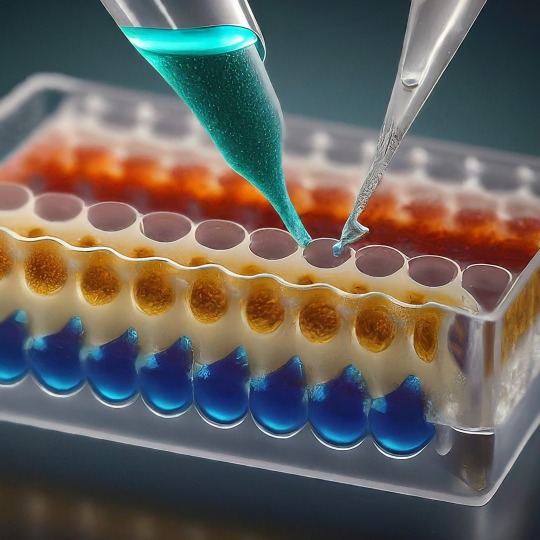
ELISA: A Powerful Tool for Detecting the Invisible
ELISA, or Enzyme-Linked Immunosorbent Assay, has become a cornerstone of medical diagnostics and biological research. This versatile technique allows scientists to detect and quantify minute amounts of target molecules, such as proteins, antibodies, and even viruses, with remarkable accuracy. In this blog, we'll delve into the world of ELISA, exploring its various types, its applications, and the exciting future directions this technology holds.
At its core, ELISA relies on the exquisite specificity of antibodies. Antibodies are highly specialized proteins produced by the immune system in response to foreign invaders. Each antibody can bind to a unique structure, called an antigen, on a specific molecule. In an ELISA, scientists leverage this binding property to create a sensitive detection system.
The 1960s witnessed a surge in interest in immunoassays, techniques that utilize the specificity of antibodies to detect target molecules. One such technique, radioimmunoassay (RIA), developed by Rosalyn Yalow and Solomon Berson, revolutionized medical diagnostics. RIA used radioactively labeled antibodies to detect antigens, offering high sensitivity. However, concerns regarding the safety of radioactive materials fueled the search for a safer alternative. The year 1971 marked a turning point. Independently, Eva Engvall and Peter Perlmann published their work on a novel technique – the enzyme-linked immunosorbent assay (ELISA). ELISA replaced radioactive labels with enzymes, eliminating the safety concerns associated with RIA. Like RIA, ELISA harnessed the specific binding between antibodies and antigens. However, it employed enzymes that could generate a detectable signal, such as a color change, upon interacting with a substrate. This innovation paved the way for a safer and more user-friendly diagnostic tool.
The basic ELISA protocol involves immobilizing the target antigen on a solid surface like a plate well. Then, a sample containing the molecule of interest (e.g., a suspected virus) is introduced. If the target molecule is present, it will bind to the immobilized antigen. Next, an antibody specific to the target molecule, linked to an enzyme, is introduced. This "detection antibody" binds to the target molecule already attached to the antigen. Finally, a substrate specific to the enzyme is added. This antigen-antibody binding is visualized using an enzyme linked to a reporter molecule. When the enzyme encounters its substrate, a detectable signal is produced, such as a color change or luminescence. The intensity of this signal is directly proportional to the amount of antigen present in the sample, allowing for quantification. The beauty of ELISA lies in its adaptability. Several variations exist, each tailored for specific detection needs.
The Four Main ELISA Formats are:
Direct ELISA: Simplicity at its finest. In this format, the antigen is directly coated onto the ELISA plate. A labeled antibody specific to the antigen is then introduced, binding directly to its target. After washing away unbound molecules, the enzyme linked to the antibody generates a signal upon addition of the substrate. Direct ELISA offers a rapid and straightforward approach, but sensitivity can be lower compared to other formats due to the lack of amplification.
Indirect ELISA: Unveiling the Power of Amplification. Similar to the direct ELISA, the antigen is first coated onto the plate. However, instead of a labeled primary antibody, an unlabeled one specific to the antigen is used. This is followed by the introduction of a labeled secondary antibody that recognizes the species (e.g., mouse, rabbit) of the primary antibody. This two-step approach acts as an amplification strategy, significantly enhancing the signal compared to the direct ELISA. However, the presence of an extra incubation step and the potential for cross-reactivity with the secondary antibody add complexity.
Sandwich ELISA: Capturing the Antigen Between Two Antibodies. Here, the capture antibody, specific for one region of the antigen, is pre-coated onto the ELISA plate. The sample containing the antigen is then introduced, allowing it to be "sandwiched" between the capture antibody and a detection antibody specific for a different region of the same antigen. A labeled secondary antibody or a labeled detection antibody itself can then be used to generate the signal. Sandwich ELISA boasts high sensitivity due to the double-antibody recognition and is often the preferred format for quantifying analytes.
Competitive ELISA: A Race for Binding Sites. In this format, the antigen competes with a labeled antigen (usually a known amount) for binding sites on a capture antibody pre-coated onto the plate. The more antigen present in the sample, the less labeled antigen can bind to the capture antibody. Following a washing step, the amount of bound labeled antigen is measured, providing an inverse relationship between the signal and the concentration of antigen in the sample. Competitive ELISA is particularly useful for studying small molecules that may be difficult to directly conjugate to an enzyme.
ELISA's Reach: From Diagnostics to Research. The applications of ELISA are as vast as they are impressive. Let's delve into some key areas where ELISA plays a vital role:
Unveiling the Mysteries of Disease: Diagnostics: ELISA is a cornerstone of diagnosing infectious diseases like HIV, Hepatitis, and Lyme disease. It detects antibodies produced by the body in response to the invading pathogen, providing valuable information for early detection and treatment. Monitoring Autoimmune Diseases: ELISA helps monitor autoimmune diseases like rheumatoid arthritis and lupus by measuring specific antibodies associated with these conditions. Cancer Screening: Certain cancers can be detected by identifying tumor markers, proteins elevated in the blood of cancer patients. ELISA assays are being developed to detect these markers for early cancer screening.
Safeguarding Food Quality: Allergen Detection: Food allergies can be life-threatening. ELISA ensures food safety by enabling the detection of allergens like peanuts, gluten, and milk in food products, protecting consumers with allergies. Monitoring Foodborne Pathogens: ELISA can identify harmful bacteria, viruses, and toxins in food, preventing outbreaks of foodborne illnesses.
Environmental Monitoring: Pollutant Detection: ELISA can detect pollutants like pesticides and herbicides in water and soil samples, contributing to environmental protection efforts. Microbial Analysis: This technique can be used to identify and quantify specific microbes in environmental samples, providing insights into ecosystem health.
Research and Development: ELISA plays a crucial role in various research fields: Drug Discovery: It helps researchers assess the effectiveness of new drugs by measuring drug-target interactions and monitoring drug levels in the body. Vaccine Development: ELISA is instrumental in developing vaccines by evaluating immune responses to vaccine candidates. Basic Research: Scientists use ELISA to study various biological processes by detecting and quantifying specific molecules involved in these processes.
Despite its established role, ELISA is evolving alongside technological advancements. New multiplex platforms allow for the simultaneous detection of various targets in a single sample, boosting efficiency in biomarker discovery and disease analysis. Automation streamlines workflows minimizes errors, and increases throughput, making high-throughput screening feasible in drug development and clinical settings. Miniaturization and portable devices enable rapid on-site diagnostics, providing healthcare professionals with real-time data for quicker interventions. Additionally, ongoing research is improving assay sensitivity, reducing background noise, and expanding detection limits, allowing for the identification of trace analytes and early disease biomarkers with greater accuracy than ever before. Integration of ELISA with emerging technologies such as microfluidics, nanotechnology, and artificial intelligence holds promise for enhancing assay performance, scalability, and data analysis capabilities.
These advancements hold promise for even wider applications of ELISA in the future. ELISA has revolutionized our ability to detect and quantify biological molecules. Its versatility, accuracy, and adaptability make it an invaluable tool across various scientific disciplines. As research continues to refine and innovate ELISA techniques, we can expect even more exciting possibilities to emerge in the years to come. ELISA's future is bright, promising to play a pivotal role in unraveling the mysteries of the biological world and improving human health.
#science sculpt#life science#molecular biology#science#biology#artists on tumblr#ELISA#immunology#immunotherapy#diagnostic management software#diagnosticimaging#history of immunology#scientific advancements#biotechnology#scientific research#scientific equipment#scientific instruments#techniques in biotechnology#scientific illustration#lab equipment#sciencenature#laboratory#lab skills#molecular diagnostics market
10 notes
·
View notes
Text
one might describe secondary antibodies as a kind of anti-anti. this joke was funnier in my head
22 notes
·
View notes
Text
Human Cell Tournament Round 1
Propaganda!


Simple columnar epithelium is a single layer of columnar epithelial cells which are tall and slender with oval-shaped nuclei located in the basal region, attached to the basement membrane. In humans, simple columnar epithelium lines most organs of the digestive tract including the stomach, and intestines. Simple columnar epithelium also lines the uterus. Simple columnar epithelium is further divided into two categories: ciliated and non-ciliated (glandular). The ciliated part of the simple columnar epithelium has tiny hairs which help move mucus and other substances up the respiratory tract. The shape of the simple columnar epithelium cells are tall and narrow giving a column like appearance.
In immunology, a memory B cell (MBC) is a type of B lymphocyte that forms part of the adaptive immune system. These cells develop within germinal centers of the secondary lymphoid organs. Memory B cells circulate in the blood stream in a quiescent state, sometimes for decades. Their function is to memorize the characteristics of the antigen that activated their parent B cell during initial infection such that if the memory B cell later encounters the same antigen, it triggers an accelerated and robust secondary immune response. Memory B cells have B cell receptors (BCRs) on their cell membrane, identical to the one on their parent cell, that allow them to recognize antigen and mount a specific antibody response.
#Simple columnar epithelium#Memory B cells#poll#polls#tumblr poll#tumblr polls#tournament poll#wikipedia#cells of the human body#science tournament#biochemistry
3 notes
·
View notes